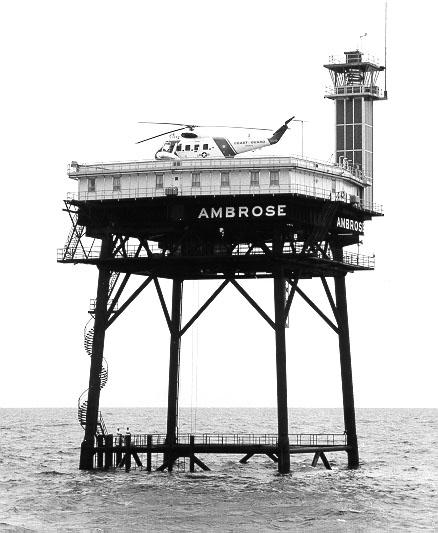 NYPR Archives & Preservation
NYPR Archives & Preservation
Guiding Lights in New York Harbor

The recorded history of foggy weather in New York City goes back to the Revolutionary War and the Battle of Brooklyn when a fortuitous fog shrouded General George Washington's retreat to the shore of Manhattan from the Red Coats approaching Brooklyn Heights. In that August of 1776, the fog was an ally, but to seamen navigating New York Harbor in bad weather, hoping to avoid its shoals and reefs, fog can prove treacherous.
In this episode of New York: A Portrait in Sound, you will hear the voices of lieutenants and engineers employed by the Coast Guard to safeguard New York Harbor, which could mean sleepless nights for them as they guided ships to safety. The episode names some of the lightships and lighthouses then in service when the episode was recorded in 1962, including the Ambrose Lightship, Scotland Lightship, Romer Shoals Lighthouse, West Bank Lighthouse, and Coney Island Lighthouse.
The ownership of lighthouses in America has passed hands a number of times in the nearly 300 year history of beacons on US shores. The first lighthouse in the US was built in 1716 in Boston Harbor. In those days, each colonial government determined the need for any lighthouses in their colony. After George Washington's fortuitous and foggy retreat, he was elected to be the first president of the U.S. in 1789, and that year Congress convened the Lighthouse Establishment, placing all pre-existing and future lighthouses under the control of the central government.
As this episode of Planet Money discusses, lighthouses are a public good. They are a safety measure all sailors need, but that the free market has no impetus to provide because there is no way to make a profit from them. Placing lighthouses in the control of the central government ensured lighthouses would continue to be built and maintained, a costly and difficult job when many beacons are in remote locations and require structural maintenance as well as personnel to light the lamp.
In fact, much of the shifting history of lighthouses, and lightships, seems rooted in cost. Lightships were used where construction of a lighthouse was not possible. The Lightship Ambrose, mentioned in this episode, graced New York Harbor's Ambrose Channel in 1823, and several ships served this post under the same name through the late 1960s. By then, control of all lighthouses and lightships had been absorbed by the US Coast Guard, and in 1967 the Lightship Ambrose was replaced with a more cost-effective texas tower. By 1985, the US Coast Guard had decommissioned the last lightship, and even the Ambrose Tower was replaced in the 2000s with a lighted buoy.
Buoys don't require personnel to operate, and eventually light towers and lighthouses didn't either, with the advent of electricity and, later, automation. In 1886, the Statue of Liberty was used as the first test of an electricity-powered beacon in the US. Even so, a keeper was still needed until automation came a century later. In 1890, the Coney Island Lighthouse, featured in this episode, was built. You can hear the voices of the Schubert family describing their duties. Frank Schubert was a civilian employee of the Coast Guard and took up his post at Coney Island in 1960, remaining there until his death, even after the light was automated in 1989.
Schubert became something of a New York City local legend, as the last civilian lighthouse keeper in the US, at a time when many lighthouses were being deemed "in excess" by the Coast Guard. Advances in navigation technology made many beacons superfluous and the cost of maintaining the structure itself was high, especially as the buildings aged. So the Coast Guard began to auction them off, preferably to a non-profit organization that would maintain the structure and its history. When no non-profit stepped up, a private auction would find a buyer.
The age of beacons is coming to a close, and lighthouses and lightships are becoming the stuff of museums. You can find one Lightship Ambrose at the South Street Seaport Museum. But whether an auctioned lighthouse becomes a museum, a bed and breakfast, or a private summer home, the Coast Guard still checks up on the light every now and then.
